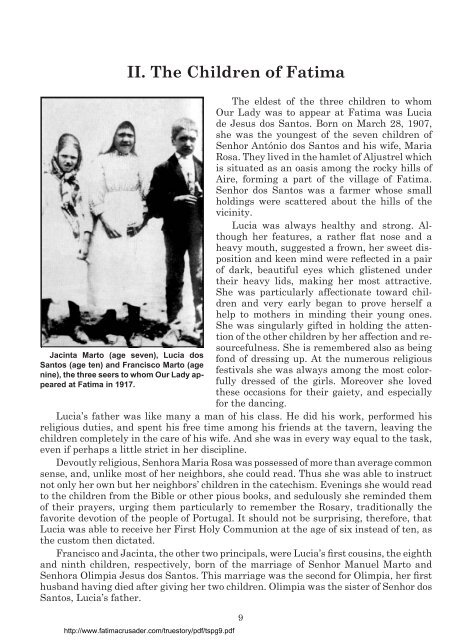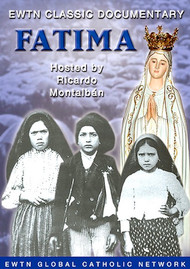Our Lady’s call to “recite the Rosary every day to obtain peace for the world and the end of the war” is as needed today as ever.
- Lucia Dos Santos Memoirs
- Fatima In Lucia's Own Words Ii Pdf
- Fatima In Lucia's Own Words Ii Full
- Sister Lucia Of Fatima Book
Sister Lúcia, one of the three children to receive apparitions and messages from the Blessed Virgin Mary at Fatima, expressed an ambitious hope to a fellow sister in a little-known letter she wrote in 1970.
FATIMA IN LUCIA'S OWN WORDS I. FATIMA IN LUCIA'S OWN WORDS II. CALLS FROM THE MESSAGE OF FATIMA. Shop for CALLS FROM THE MESSAGE OF FATIMA at EWTNRC.com and support the ongoing mission of Mother Angelica. Religious books, artwork and holy reminders. Fatima in Lucia's Own Words II This text from Sister Lucia's hand which, in its literary genre, is similar to the Four Memoirs composed between the years 1935 and 1941 and already published, originated at the request of the Rev. Luciano Guerra, Rector of the Sanctuary. In 1967, Sister Lucia traveled to Fatima to celebrate the 50th anniversary of the apparitions, presided over by Pope Paul VI. She went again in 1982, when Paul John Paul II came to the Shrine on 13 May to give thanks for the saving of his life during the assassination attempt of 13 May 1981, and again when the Pope came there in 1991,. Fatima in Lucia's Own Words. Paperback – June 1, 1976. By Lucia Santos (Author) 4.8 out of 5 stars. See all formats and editions. Hide other formats and editions. The apparitions and miracles that occurred at Fatima, Portugal in 1916 and 1917 rocked the country at the time and the rest of the world soon after. Let us look back on the events of Fatima — in Servant of God Lucia dos Santos’ own words.
During her hidden life in the convent, Sr. Lucia wrote several well known memoirs and works of spirituality, including Fatima in Lucia’s Own Words and Calls from the Message of Fatima.

She also wrote a number of letters. One largely unknown letter, dated Sept. 16, 1970, is addressed to Mother Martins, and speaks eloquently about the prayers of the Rosary.
Throughout, she explains the divine origins of the prayers of the Rosary, calling this devotion a ‘Trinitarian and Eucharistic prayer.’
Before she ends, she expressed this incredible and ambitious desire:
I have great hopes that, in the not too far distant future, the prayer of the Holy Rosary will be proclaimed a liturgical prayer, because all its parts share in the Sacred Liturgy of the Eucharist.
Sister Lúcia de Jesus dos Santos OCD, better known as Sister Lúcia of Fatima, lived her life as a Carmelite nun at the cloistered convent of Coimbra, Portugal. He days were spent in prayer and penance following the spirituality of St. Teresa of Avila and St. John of the Cross.
It was the continuation of the extraordinary events of 1917, when the Blessed Virgin gave her and two other children — Blessed Jacinta and Blessed Francisco — special messages about prayer and penance, devotion to the Immaculate Heart of Mary, and three secrets concerning future events in the life of the Church and the world.
At Fatima, Our Lady repeated asked the children and the world to pray the Rosary.
To date, no pope or meeting of the pope and bishops has yet proclaimed the Rosary as a liturgical prayer. The Catechism of the Catholic Church does make four references to the Rosary. Paragraph 971 says the prayer of the Rosary is the “epitome of the whole Gospel.”
In paragraph 2678 it says, “Medieval piety in the West developed the prayer of the Rosary as a popular substitute for the Liturgy of the Hours,” while section 2708 reminds us that the Rosary is a good method of meditating on the mysteries of Christ.
“Besides sacramental liturgy and sacramentals, catechesis must take into account the forms of piety and popular devotions among the faithful,” paragraph 1674 tells us.
“The religious sense of the Christian people has always found expression in various forms of piety surrounding the Church's sacramental life, such as the veneration of relics, visits to sanctuaries, pilgrimages, processions, the stations of the cross, religious dances, the rosary, medals.”
So, the Catechism has several things to say about the Rosary, but no mention of it being a liturgical prayer.

Lucia Dos Santos Memoirs
Vatican II’s Sacrosanctum Concilium (no. 98) says: “They too perform the public prayer of the Church who, in virtue of their constitutions, recite any short office, provided this is drawn up after the pattern of the divine office and is duly approved.”
In the past, some religious orders would pray the Little Office of the Blessed Virgin Mary as a properly liturgical prayer, and it remains an option today, so perhaps the same recognition could be extended to the praying of the Rosary?
The 150 Hail Marys said when one prayers three sets of mysteries correspond with the 150 Psalms prayed in the Liturgy of the Hours.
And since 1573, the Church has even had a dedicated liturgical feast to celebrate the Rosary, complete with its own set of prayers for Mass and Vespers. That’s not to mention the many other liturgical feasts of Our Lady and prayers to her included in the Liturgy of the Hours and the Mass.
In his encyclical, Rosarium Virginis Mariae, St. John Paul II wrote of the Rosary: “Not only does this prayer not conflict with the liturgy, it sustains it, since it serves as an excellent introduction and a faithful echo of the Liturgy, enabling people to participate fully and interiorly in it and to reap its fruits in their daily lives.”

Fatima In Lucia's Own Words Ii Pdf
We could go into the many Rosary encyclicals, speeches, books, meditations and acts of devotion by saints and popes alike, and it would fill volumes.
There seems plenty of reasons to support Sister Lucia’s wish to see the Rosary elevated to new heights in the Church, but will it ever been fulfilled?

Perhaps some would feel a sense of reservation about tampering with the Rosary, in much the same way some objected to the new Mysteries of Light being introduced, albeit as an option. The Rosary was given to us as a popular devotion, and it should stay that way. If it was good enough for St. Maximilian Kolbe and Padre Pio, then it’s good enough for us.
And in an era where debates over the liturgy are as heated as ever, introducing yet another liturgy-related issue could be unwise and unnecessary, maybe even distracting Catholics from the seeing the Rosary as primarily something we pray and mediate upon.
Fatima In Lucia's Own Words Ii Full
“The prayer of the Rosary, after the Liturgy of the Most Holy Eucharist, is what most introduces us to the intimate mystery of the Most Holy Trinity and the Eucharist, what most brings us to the spirit of the mysteries of Faith, Hope and Charity,” wrote Sr. Lúcia in the same letter.
Sister Lucia Of Fatima Book
Whether it happens or not, Our Lady’s call to “recite the Rosary every day to obtain peace for the world and the end of the war” is as needed today as ever.
